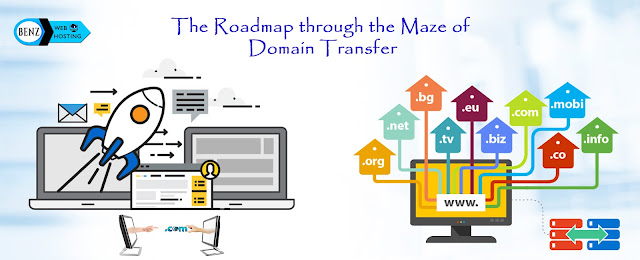The Roadmap through the Maze of Domain Transfer
One who is fanatically looking up pages on how to successfully
transfer a domain without much hassle, surely needs no introduction to what
domains or domain hosting is, or the very basic of a domain transfer. However,
the very fact that you are looking up ways to successfully conduct your domain
transfer is suggestive of the fact that there is some information which is
unknown or maybe unclear to you , that brings you here in the very first place.
So, I’d make an attempt to put down the fundamentals of domain transfer and the
easier ways to go about it.
 |
| Domain Name Transfer |
As a start-up, procuring a domain name could be a very tedious and
confusing process, especially at the step to transfer a domain. The small bit
of problem is in the fact that, even though technology has evolved at light
speed almost, the procedure of Domain transfer hasn’t undergone much, so to
state, since the inception of the internet which basically translates to domain
transfer yet being a confusing and fastidious process which with a little
effort and proper understanding could be simplified to a great deal.
If the transfer process is bothering you, there’s nothing to sulk,
most people are equally confused like you, if not more! I hope that by the end
of this article you’ll be all guns blazing, set to conquer domain transferring
with confidence.
So, basically there are two broad ways of domain transfer:
- · A push ( also referred to as an account change)
- · A transfer
Although people often have a tendency to clump them up under the
same veil, they are distinctively different from one another, each with their
own share of pros and cons. Most importantly, one of them being way easier than
the other.
What is a
‘push’?
This is like changing rooms within the same hotel, where the hotel
acts as the Domain. It is simply transferring a domain from account to another,
the registrar being the same. This is by far the simplest known way of transferring a domain
and happens instantly. There are no additional worries or burdens to be
concerned about like authorisation codes etc., the only requirement is to keep
the account under the same registrar, and they’d be more than happy to serve
you! For example, you purchase a domain name from an agent and find out they
have the domain registered with the same host where you too have a per-existing
account. Thus, once the purchase is made, you just have to provide your account
number and mail id of the same domain host and the seller will transfer or
‘push’ the domain to your account. This is confirmed by the domain hosting
agency via an email, the confirmation to which completes the process.
This is the Universal domain transfer that everyone generally talks
about and is unfortunately not one of the easier ways to get a domain recently
purchased. The standard transfer thus involves changing of the domain registrar
and shouldn’t be attempted unless it’s the only option left. For example, if
the domain is registered with some random company or seems suspicious for
various reasons suddenly, while all your other accounts are registered with a
premium domain hosting
company like Go Daddy, you could maybe want to secure this solitary account
and bring all of it under Go Daddy that is when the need for Standard transfer
arises.
The procedure of Standard transfer is a little tricky and there are
certain facts which must be considered and kept in mind before proceeding with
it. The domain owner has to unlock the domain and give you (the buyer), access
to the authorization code or domain secret, in order to transfer from
registrars. The procurement of the authorization code is the pre-requisite in the
initiation of the transfer proceedings. The authorization part, as easy as it
seems, is not always so. Many domain registrars (Go daddy) send the domain
owner with two transfer authorization codes. These two codes along with the
original authorization code are required to accept the transfer. It is here
that many get stuck up and is probably another reason why one should actually
adhere to the push method unless absolutely necessary, however, here’s the
simplified deal to further proceedings.
After securing the payment for the domain, you ask this new domain
registrar to disclose their authorisation code. The transfer is then initiated
with your initial registrar and the seller receives the email with the two
transfer authorisation codes that you need to enter along with the newly
procured authorisation code from the seller. This is the final step, to input
all the three codes, the two codes from your seller (that your previous
registrar provides the seller with) and the new authoritative code from the seller,
to complete the transfer.
The transfer is not immediate and is one of the drawbacks as
compared to the ‘push’ method, and takes some time. Different registrars
function as per their clauses and the time of transfer could range from
anything between a days to a week. Don’t freak out! If you have secured your
transfer and done a thorough checking before switching registrars, there’s no
discrepancy and the transfer would be completed within the stipulated time!
Comments
Post a Comment